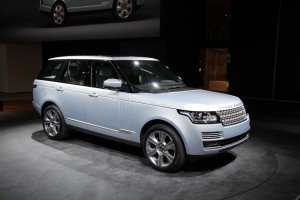
Even the folks from Land Rover are getting into the hybrid segment with the Range Rover Sport Hybrid.
It seems like everyone is getting into the battery-car game, whether with hybrids, plug-ins and full battery-electric vehicles. Among the latest to reveal plans is Land Rover, the British maker pulling the wraps off the new diesel-electric Range Rover hybrid during the opening day of the 2013 Frankfurt Motor Show press preview.
In a bit of a surprise, a senior official has told TheDetroitBureau.com that Land Rover has apparently reversed course and will be bringing the new high-mileage package to the United States at an as yet-unspecified date.
“It’s not a matter of ‘if,’ but ‘when,’” revealed Andy Goss, the outgoing CEO of Jaguar-Land Rover’s U.S. operations, who will soon become the company’s global marketing czar.
The new system pairs a 3.0-liter V-6 turbodiesel with a 47-horsepower electric motor to create a combined 335 horsepower and 516 pound-feet of torque. An eight-speed ZF automatic gearbox links the hybrid package to all four wheels.
“We are extremely excited to introduce the Range Rover and Range Rover Sport Hybrids, the world’s first hybrid SUVs with legendary Land Rover capability,” said John Edwards, Land Rover Global Brand Director. “The addition of a smooth electric drive enhances refinement, cuts CO2 emissions and delivers staggering performance on a par with our SDV8 engine.”
The diesel-electric drivetrain actually will be packaged into two different models, the flagship Range Rover and the newer Range Rover Sport. The Brits claim that the bigger, heavier model will charge from 0 to 100 kmh – 0 to 62.5 mph – in just 6.9 seconds and reach a top speed of 135 mph. The smaller Range Rover Sport Hybrid will get there in 6.7 seconds, on its way to a maximum 145 mph.
Perhaps just as impressive is the estimated 44.1 mpg the green drivetrain is expected to yield in the Range Rover Sport Hybrid, the diesel-electric combination expected to trim CO2 emissions – something Europeans focus on – by about 26% compared to the conventional Rover diesel drivetrain.
The new system will leapfrog earlier-generation hybrid drivelines by adapting a smaller, lighter and more energy-dense, liquid-cooled lithium-ion battery pack. In all, the entire assembly adds just 265 more pounds to the base weight.
(Range Rover goes hybrid. For more information, Click Here.)
The system is capable of operating in EV mode at speeds up to 30 mph before the diesel engine fires back up, and it can go for up to a mile on battery power alone.
Land Rover is currently hoping to demonstrate the durability of the new hybrid drivetrain with an expedition running along the old Silk Trail that is expected to take three of the diesel-hybrids through 12 countries, a 10,000-mile journey planned to wrap up on October 15.
(Click Here to read Jaguar unwraps un-Jag at Frankfurt.)
Land Rover long has been cautious about getting into alternative propulsion – as much as anything due to its limited budget. But it has gotten much-needed funding from Indian parent Tata Motors to move ahead with the diesel system, an understandable decision considering it would have been near-impossible for the maker to meet tightening European CO2 emissions any other way.
And it will likely need the diesel-hybrid system to remain a player in the U.S. market, as well, considering the tougher federal fuel economy standards coming into play in 2016 – with even stiffer rules taking effect in 2025.
Don’t be surprised to see the system reach American showrooms within the next several years, other sources hint.
That might surprise those who note that there’s a stiff price premium on conventional hybrids, and an equally hefty penalty for diesel engines. Put them together and the price tag takes another big leap.
Not to worry when you consider the price of a conventionally powered Range Rover or Sport, stressed CEO Goss. “For those who can pay one of the cars, they will pay” for the hybrid.
